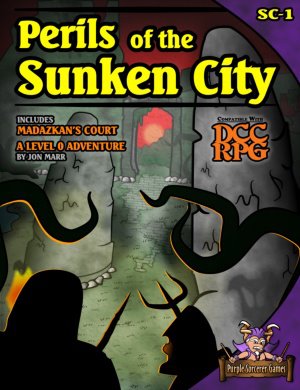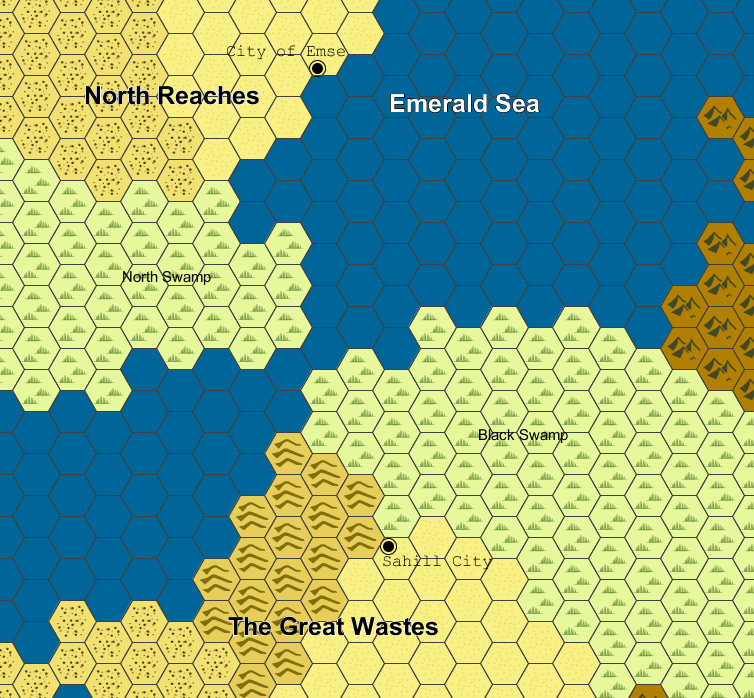 I have been running a Dungeon Crawl Classics RPG campaign online via Google+ Hangouts and Roll20. The game has been going since the first of August and we typically play for 2 to 2.5 hours on Tuesday nights. We have had a couple of canceled sessions due to crazy lives, but have had a pretty stable campaign overall.
I have been running a Dungeon Crawl Classics RPG campaign online via Google+ Hangouts and Roll20. The game has been going since the first of August and we typically play for 2 to 2.5 hours on Tuesday nights. We have had a couple of canceled sessions due to crazy lives, but have had a pretty stable campaign overall.
I started the campaign with The Perils of the Sunken City from Purple Sorcerer Games, a 3rd party publisher for the DCC RPG system. Several of my players were familiar with the Goodman Games modules already out which was a factor in choosing to start with the Purple Sorcerer Games products.
I liked the initial setting because it included a decent sized, but financially poor city and a large area of swamps to the South of the city. The swamps were vast portions of the city reclaimed over the centuries as the city was forcefully migrated northward by nature. The setting also includes a “sending stone” which acts like a randomly teleporting stone. Prospective adventurers place their hands on the stone and they are transported to some location. I thought this would allow me to use a myriad of modules that might not otherwise link together well.
Essentially, the modules offered a starting point with enough detail to hit the ground running, but enough white space for me to shape it into anything the players or I wanted.
The first module went quite well with some overland exploration in the swamp followed by a rather lethal dungeon for the ending of the adventure. The Perils of the Sunken City served quite well for a 0-level funnel and really helped shaped the character development of those that survived.
With the group surviving their first foray into the Sunken City they returned as heroes to the little settlement just outside the city walls proper. The group took about three months of in-game time to determine their path forward (i.e. class) and spend their hard fought gold. Two of the players also selected their patron from an entity featured at the end of the module. I ended up doing a complete patron write-up for that patron which both players have been using.
From here I wanted to run The Ooze Pits of Jonas Gralk for the group. It made use of the same sending stone for a start and further reinforced my base of the Great City and the Sunken City in the swamps to the south. I blended the storylines a bit and offered a possible option for controlling the sending stones instead of submitting to its randomness via an item that would be found at the end of The Ooze Pits of Jonas Gralk.
It took us six session (2 hours each) to play through The Ooze Pits of Jonas Gralk. I am sure other groups have played through this faster. I tend not to steer players too much, so I let their investigations go and handle things on they fly when they take actions outside what might be outlined in a module. If they want to chat with someone they encounter, I am always happy to carry on that conversation instead of brushing it aside. I think that is a good thing as long as it helps get them information they desire. But it does add time to play through the module. In fact, though we are pretty much done with the module as written, they have a few things they still want to wrap up.
Choosing to start with the Purple Sorcerer Games Sunken City line has proven to be a good start for us. I feel like we have a solid set of characters now, some backgrounds and themes starting to show through and the start of a campaign world to play in. With the use of sending stones it will also be relatively easy to work in other adventures from other publishers as well. There is a whole area of exploration behind how the sending stones came to be and are they really limited to just taking you to portions of the swamp?
For those interested I do keep an Adventure Log at the Obsidian Portal site I use for this campaign. While I don’t post detailed session reports here, I do try to keep the adventure log updated. Feel free to check it out. I caution you that you will run into spoilers for The Perils of the Sunken City and The Ooze Pits of Jonas Gralk over there as you read about our group’s adventures.

